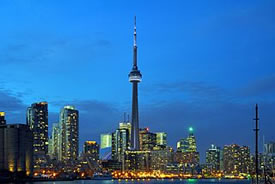Finding nature at home

Toronto skyline (Photo by Taxiarchos228, Wikimedia Commons)
Nature and cities can seem like opposing ends of an ecological spectrum. Many see nature in its purist form only in wilderness — where our human influence is minimal, or at least hidden. Cities are the grey places on the map that testify to our domination over nature. Places of noise, air pollution, dirty water and big city lights. Places where nature has been pushed out, and the very thing that nature needs to be protected from.
In reality, nature knows no boundaries and the lines between what is nature and what is city do not exist. When we replace natural habitats with city habitats, there are always places where nature holds on, and places where nature returns. This can be found in the animals that adapt to our city habitat, in the secret ravines and valleys that are refugia of nature past and in the omnipresent and eternal cycles of water, matter and energy. Indeed, cities are an intricate part of the ecological fabric of Canada and the world. Protection and restoration of many important habitats and processes cannot happen without considering cities.
Another reason why conservation cannot ignore cities is people. While the world may see us as a nation of trappers, loggers and farmers, Canadians are in reality a nation of city-dwellers. Despite our patriotic affinity for nature, it is the new city habitat that most Canadians chose to live, and where most Canadians experience nature. While our collective identify may be shaped by rocks, water and trees — and place names like Algonquin Park, Killarney and Banff may stir your soul, these are the places we escape to; not the places where we live.
Over the last 150 years, our national rural/urban ratio has almost completely reversed, and four in five Canadians now live in cities. The percentage of Canadians living in cities puts us in the same category as the United Kingdom, United States, Saudi Arabia and South Korea. We also know that the number of people living in cities is going to grow. In Ontario for example, the population is projected to grow by to almost 17.4 million by 2036. These new Ontarians will not be evenly distributed. They are not moving to the wilds of northern Ontario, but to the Greater Toronto Area (GTA) and surrounding regions. Indeed The GTA mega-city is the fourth-most rapidly growing region in North America, and by far the fastest growing in the Great Lakes basin. In Alberta, the population will increase by about one-third in the next 25 years, growing from almost four to six million people, and most of this growth will be in Edmonton and Calgary.
Of course, this growth does create urgency for those natural areas in the looming shadow of growing cities. While many of these new city-dwellers will live in compact urban areas, there will be continued expansion of urban boundaries, and there will be important habitats that need to be protected from growing cities and valued in smart urban design.

Peregrine falcon (Photo by Frank Doyle USFWS)
We absolutely need to protect wilderness, natural areas and rural landscapes. However, we should not leave cities completely out of the conservation equation just because they are cities. Not all places in the city habitat are the same. Just as a farming community or even wilderness forest contains key areas for nature, so does a city. Many studies have shown a gradient in the diversity of species in cities. While the concrete “jungle” may support only a few species, parks, mature neighborhoods and city river valleys have more plants and animals. Despite our best efforts to push nature out, there are natural places left in the city. Many species, ranging from deer to coyotes to cliff swallows, have found their way back in and have adapted to this new city habitat. Some rare species, such as chimney swifts and peregrine falcons, have come to depend on city habitats.
Cities have important habitats that need to be conserved and restored. Around the world, we have built most of our cities in places of high biodiversity and places of natural abundance, such as coastal areas, river valleys and habitat edges. In cities like Toronto, while we have almost obliterated the original landscape, there are remnants of important habitats such as black oak savannah and ravine forests. These habitat remnants should be protected. They can remind us of lost landscapes and serve as important benchmarks. Maybe most importantly, the stage for diversity and abundance that created a high diversity of species and habitats in the past is still there, and maybe still waiting.
Cities can play an important role in regional and even continental ecological corridors, and are important for migratory species. Many cities and near-urban areas provide high quality stopover habitats for migrating birds. These habitats within a city context are perhaps even more important than sites where there is an abundance of stopover habitat because they may represent the only suitable resting places.
The quality of nature in cities affects the quality of nature in the surrounding landscape. Healthy urban forests and waters in a city can benefit surrounding watersheds and landscapes, while cities with dirty water and an abundance of invasive species can degrade surrounding landscapes and watersheds.
Perhaps most importantly, cities depend on nature for their very well-being. Nature in cities reduces energy bills, cleans the air and protects us from floods. There is a growing body of evidence that nature makes us better people and builds better communities. Creating cities where people want to live is also good for nature. Well-planned cities can reduce our collective ecological footprint. They can be gateways to concern and literacy about nature and conservation that are crucial for creating demand and supporting the protection of species and habitats outside of cities.
Cities are nature, nature is city. As more city threads are woven into our landscape fabric we need to look at cities not as the opposite of nature conservation, but as opportunities for nature conservation.


